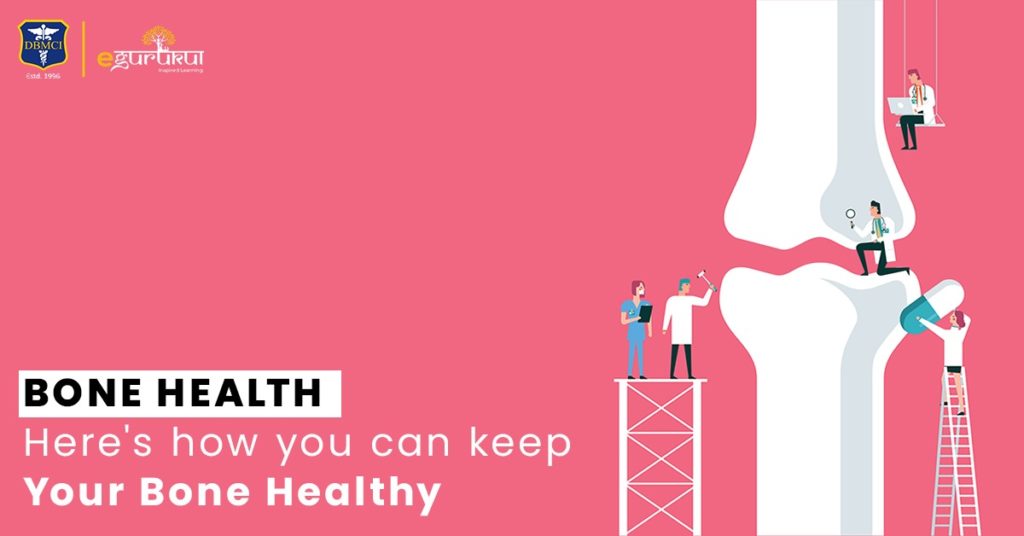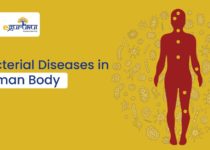Bone Health: Here’s How You Can Keep Your Bone Healthy

Bones are rigid tissues that provide shape and support to the body and enable mobility. Also, they protect organs.
A bone is a storage site for minerals and a production and development site for blood cells. Bone health is something one must be careful about. Keeping your bones in a good condition is important to maintain mobility. You can improve bone health by maintaining a stable diet, regular physical activity, and a healthy lifestyle. Let us look at the topic in greater detail.
What Is a Bone?
A bone is a highly unique tissue. It is hard and strong yet lightweight. It is made of hard tissue called osseous tissue. It is a type of connective tissue with a honeycomb similar to a matrix that helps maintain bone rigidity. A bone is made of osseous tissue (about 70%) and the bone matrix (30%). The bone matrix is called ossein, and it is composed of 90-95% elastic collagen fibers. The collagen provides fracture resistance, preventing breaking of bones. The matrix is a chemical compound of mineral salts and calcium phosphate that is known as calcium hydroxylapatite. The entire process of chemical compounding is known as bone mineralization.
Types of Bone
At birth, every human being has 270 soft bones. Later, during the process of growth, many of them fuse, and in adulthood, we have 206 bones. Bones are of 5 different types – long bones, short bones, flat bones, sesamoid bones, and irregular bones. Even though all these bones are made of the same bone components, they are of different shapes and serve different purposes.
Long Bones
Bones that are longer in length and not wider come under this category. Most limb bones and the ones in the toes and fingers come under this category except for carpal bones, tarsal bones, and the kneecap. Clavicles are long bones that differ in shape, so they are called modified long bones.
Short Bones
Bones with the same length and width come under the short bone category. The eight carpal bones in the wrist and seven tarsal bones in the ankle are known as short bones. Some classification takes patella in the knee as a short bone while others neglect it.
Flat bones
Flat bones show a unique structure, and has a layer of spongy bone wrapped on both sides with compact bones. Most of the cranium (skull), the ilium (pelvis/hip bone), sternum, and rib cage are made of flat bones. Their main purpose is to protect organs from external injuries.
Sesamoid bones
A sesamoid bone is a bone embedded within a tendon or a muscle. It mainly contributes to tendon function.
Irregular bones
The non-categorized bones are together called irregular bones. They are the spinal cord, pharynx, trachea, hyoid, maxilla and the list goes on. There are, in total, 33 irregular bones.
Bone Remodeling
Bones have an important function called bone remodeling. Bone cells reabsorb minerals and form newly remodeled bones. They never stay in the same form, bone cells constantly remodel and maintain the bone form. Bone cells are of three types: osteoblasts, osteoclasts and osteocytes. Osteoblasts – Osteoblasts are responsible for bone formation and mineralization during new bone formation as well as bone remodeling. They produce a protein called osteoid, which is mineralized to form bone.
Osteocytes
Osteocytes are inactive osteoblasts that become embedded inside the bone they created. They are the longest living bone cell in the body. Osteocytes are capable of bone deposition and resorption. They stay in touch with other osteocytes by transmitting signals.
Osteoclasts
Osteoclasts are the destroying cells of the bone. They are the largest of all and have multiple nuclei. They carry out bone resorption during which a bone is demineralized and broken. Osteoclasts work in injuries or any other pathologic conditions to bring back the normal bone anatomy.
For a detailed study about bone and its components, subscribe to the DBMCI Orthopedics package and get unlimited access to lecture videos, question banks, and test series. Check out their website.
Importance of Bone Health
Regardless of any factor like age, gender or race, you have to prioritize your bone health. Most people think that bone growth stops after adolescence. But that is not the case, your bone remodeling process takes place throughout your entire life. For the first three decades of your life, you gain bone mass. But, after that, you need to put more care into maintaining bone health. Because after that, you lose more than what you gain. By following certain lifestyle changes, you can maintain bone health.
Bad Bone Health/Factors Affecting Bone Health
Many factors affect your bone health, such as:
- Calcium Diet – Your diet should have an adequate amount of calcium content (see chart below). A diet with less calcium diminishes bone density leading to fractures.
- Physical Activity – Consistent physical activity keeps your body healthy. Regular exercise yields many positive results – for instance, regular physical activity prevents osteoporosis.
- Gender – Normal physiology in women is such that they have less bone density than men. Increased levels of testosterone in men increase bone density. Estrogen is a female sex hormone that influences bone density, similar to what testosteron does for men. It is responsible for bone density in women. Women around the age of menopause are more prone to osteoporosis due to a drop in estrogen level.
- Medical Conditions – Many health illnesses have osteoporosis (weak bones or bone density wasting) as an associated condition. Bones become less dense, and the risk of fracture increases in osteoporosis.
- Illnesses that lead to osteoporosis are rheumatoid arthritis, chronic kidney disease, overactive parathyroid gland, organ transplant, and in some cases, type1 diabetes.
- Some conditions lead to poor calcium and vitamin D absorption. Like gastric bypass, cystic fibrosis, and eating disorders like anorexia or bulimia.
- Medications administered to treat health ailments can also affect calcium concentration or increase bone resorption, just like in cancer treatment.
- Long-term use of corticosteroids increases the risk of osteoporosis. Medications like prednisone, cortisone, prednisolone and dexamethasone can also be the culprits.
- Traits/Race affecting bone health – A person’s sex, race, and genes determine his/her body development. Several diseases are inherited from parents causing bone deformities. Such as osteogenesis imperfecta, Marfan syndrome, Hurler syndrome, and so on. Race differences also determine bone density. For example, African Americans typically have higher bone density growth than European Americans.
- Tobacco and Alcohol Use – Tobacco use affects bone health, increasing the risk of osteoporosis. Smoking decreases calcium absorption in the body. Also, nicotine present in cigarettes slows the development of osteoblasts (bone-forming cells).
- Old Age – As you grow old, bone production is reduced, and its resorption increases. Thus bones become thin and weak.
Maintaining a Healthy Bone
Following are the steps regarding how you can keep your bones healthy. Try to follow them and stay in shape.
- Adequate Calcium Intake – As discussed earlier, every person has to take a daily recommended value of calcium in his/her diet to maintain a healthy bone density. Good sources of calcium are tofu, kale, broccoli, soy milk, salmon, and dairy products. You can add them in appropriate amounts to your daily meals.
Recommended Value of Calcium Intake
| Gender | Age Group | Calcium Intake (mg/day) |
| Female | 19-50 | 1000-2500 |
| Over 50 | 1200-2000 | |
| Male | 19-50 | 1000-2500 |
| Over 50 | 1000-2000 |
- Vitamin D and K Supplements – Vitamin D is essential for the absorption of calcium in the body. Vitamin D sources include tuna, salmon, trout, oily fish, eggs, cereals, and sunlight. Sunlight is a good source of vitamin D, so better take that walk in the morning. Vitamin K helps bone formation by promoting osteocalcin, an enzyme that binds to minerals in bones and prevents calcium loss.
- Physical Activity – Any kind of exercise is good for your health. As far as bone health is concerned, try stretching, weight-bearing and jogging.
- Medication Abuse – If you are on medications like corticosteroids, do consult your doctor about the vitamin supplements. Whenever you get long-term prescriptions from a doctor, talk about the associated supplement needs. And visit your doctor periodically.
- Substance Abuse – Quit bad lifestyle habits like alcohol addiction, tobacco usage, and smoking. By avoiding them, you can save yourself from osteoporosis.
- Maintain Your Body Weight – A nutritious food rich in all types of vitamins and minerals help your bone health.
- If you have a low BMI, you face a high risk of getting osteoporosis and osteopenia. It is mainly because of low bone density.
- On other hand, obese people are more prone to fractures due to the stress of excess weight.
- For some reason, a sudden loss or gain in weight is considered an injury to bone health. Especially if you are repeating it multiple times, your bone quality might get compromised. So, try to maintain a stable weight.
Meet our Orthopaedics Guru Dr. Sushil Vijay
Dr. Sushil Vijay (FICS, Orthopedics surgeon, ATLS provider). He completed his graduation from Lucknow in 2008. After completing his post-graduation, he joined senior residency at Delhi Govt. Hospital. He has successfully completed his fellowship in joint replacement from Germany, IOA – Synthase trauma fellowship from AIIMS, New Delhi, and a Hon’ spine fellowship from ISIC, New Delhi. He is into private practice as a consultant orthopedic surgeon at New Delhi as well as academics. He is national-level faculty of orthopedics with DBMCI and author of a textbook on orthopedics, which is designed for MBBS students.
Conclusion
Bone health needs to be maintained by people of all age groups. Stay active and eat well. And a morning walk thrice a week can do wonders for your bone health management. Make good health choices now, so that you don’t regret later.


